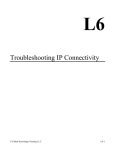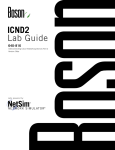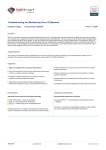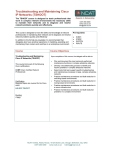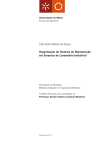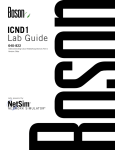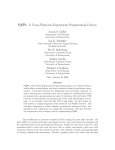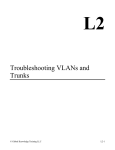Download Troubleshooting Scenarios
Transcript
C Troubleshooting Scenarios © Global Knowledge Training LLC C-1 Appendix C: Troubleshooting Scenarios Procedure These are the troubleshooting scenarios at the time this lab guide was written. Troubleshooting VLANs and Trunks File name Description VLAN-a.txt VLAN 2x is deleted; interface FastEthernet0/10 is still assigned to VLAN 2x. The VLAN must be re-created. Note that this file deletes VLANs 21, 22, 23, 24, 25, 26 so it can be used for all pods. VLAN-b.txt The switch’s FastEthernet 0/11 is changed to switchport mode dynamic auto. The core switch interface is also configured for dynamic auto, so they don't negotiate trunking. VLAN-c.txt The switch’s FastEthernet 0/1 to PxR1 native VLAN was changed to VLAN 10; it should be VLAN 1. VLAN-d.txt The switch’s FastEthernet 0/1 to PxR1 was changed to be an access port; it should be a trunk. VLAN-e.txt The switch’s FastEthernet 0/2 interface is shut down. It should be operational. VLAN-f.txt The switch’s FastEthernet 0/2 is in VLAN 1. It should be on VLAN 3x. VLAN-g.txt The switch is only allowing VLAN 1 on the FastEthernet 0/1 trunk to PxR1. It should allow VLANs 1, 1x, 2x, 3x on this trunk. VLAN-h.txt The switch’s address is configured under interface VLAN 1 but it is in the wrong subnet. The address is 10.1.77.100; it should be 172.16.1.1x3, in the VLAN1 subnet. Troubleshooting IP Connectivity File name Description On PCs No entry in local hosts file for “Server”; need to add. IP-SW-a.txt The switch’s default gateway is set to wrong address, 10.10.7.1. It should be 10.10.x.1. IP-PxR2-b.txt The default route on PxR2 to PxR1 was deleted. It should be ip route 0.0.0.0 0.0.0.0 10.3.x.1. Note IP-R1-c.txt C-2 There is a separate file for each pod; substitute the “x” in the file name with your pod number. In ACL 100 on PxR1, the permit ip any any was replaced with permit tcp any any. © Global Knowledge Training LLC Appendix C: Troubleshooting Scenarios Troubleshooting EIGRP Note There is a separate file for each pod; substitute the “x” in the file name with your pod number. File name Description EIGRP-PxR1-a.txt The passive-interface GigabitEthernet 0/1 command is configured; it should not be there. EIGRP-PxR1-b.txt The GigabitEthernet 0/1 interface is shutdown; it should be up. EIGRP-PxR1-c.txt The commands network 10.1.x.0 0.0.0.255 and network 10.2.x.0 0.0.0.255 were deleted. They need to be put back. EIGRP PxR1-d.txt There is an incorrect IP address and mask on interface GigabitEthernet 0/0.3x. It is 10.3.7.1/24; it should be 10.3.x.1/24. EIGRP PxR1-e.txt There is an incorrect EIGRP AS number; it is 10 but it should be 100. EIGRP PxR1-f.txt The passive-interface GigabitEthernet 0/0.3x command is configured; it should not be there. EIGRP PxR1-g.txt The forth octet of the EIGRP wildcard mask in the network 192.168.xx.0 0.0.0.0 command is wrong; the mask should be 0.0.0.255. EIGRP PxR1-h.txt The “K-values” (metric weights) were changed from the defaults. You can change them back to the defaults by either using metric weights 0 1 0 1 0 0, or (even easier) no metric weights; both of these commands go under the EIGRP process (router eigrp 100). © Global Knowledge Training LLC C-3 Appendix C: Troubleshooting Scenarios Troubleshooting OSPF Note There is a separate file for each pod; substitute the “x” in the file name with your pod number. File name Description OSPF-PxR1-a.txt The fourth octet of the OSPF network 10.3.x.0 0.0.0.0 area x command is wrong; the mask should be 0.0.0.255. OSPF-PxR1-b.txt The address in the network 192.162.xx.0 0.0.0.255 area 0 command is wrong; it should be 192.168.xx.0. OSPF-PxR1-c.txt The passive-interface GigabitEthernet 0/1 command is configured; it should not be there. OSPF-PxR1-d.txt The gigabit 0/0.3x interface is shutdown; it should be no shutdown. OSPF-PxR1-e.txt The network 10.10.x.0 0.0.0.255 area x command is missing. It needs to be put back. OSPF-PxR1-f.txt The hello interval on GigabitEthernet 0/0.3x is set to 5 seconds, it should be 10 seconds. You can change it using the interface configuration command ip ospf hello-interval 10. OSPF-PxR1-g.txt PxR1’s router ID is set to 10.200.x.2, resulting in the same router ID as PxR2. PxR1’s router ID should be its own loopback 100 interface address. You can remove the router ID using the router configuration command no router-id; you will have to restart the OSPF process, using the clear ip ospf process command in order for this change to take effect. OSPF-PxR1-h.txt The IP address on GigabitEthernet 0/1 is set to 192.168.77.1/24. It should be 192.168.xx.1/24. Troubleshooting a Serial Connection Note C-4 There is a separate file for each pod; substitute the “x” in the file name with your pod number. File name Description Serial-PxR1-a.txt The password on the username command is changed from cisco to Cisco. On the Serial 0/0/0 interface the PPP authentication mode is changed to PAP, and then the interface is shutdown. The authentication mode should be CHAP. © Global Knowledge Training LLC Appendix C: Troubleshooting Scenarios ICND2 SuperLab File name Description Super-SW-a.txt The link between PxSW and the core switch should be configured for EtherChannel using LACP, but the EtherChannel is not working (one port is blocked by STP). This is because PxSW is configured for PAgP, but core switch is still configured for LACP. To fix, change PxSW to LACP. Super-R1-b.txt The Serial 0/0/0 interface is shutdown. The encapsulation is changed from PPP to HDLC. The encapsulation ppp command needs to be put back on the interface, and the interface needs to be enabled. Super-PxR1-c.txt In the OSPF process 1, the network 192.168.x.96 0.0.0.31 area x command is missing. It needs to be put back. Note Super-R1-d.txt There is a separate file for each pod; substitute the “x” in the file name with your pod number. The ipv6 eigrp 100 command is missing on interface GigabitEthernet 0/1. © Global Knowledge Training LLC C-5 Appendix C: Troubleshooting Scenarios C-6 © Global Knowledge Training LLC






